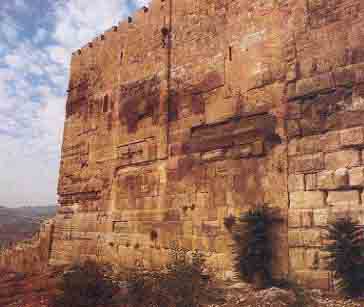Image Details

Leen Ritmeyer
Like Robinson’s Arch on the western wall, the arch on the eastern wall supported a stairway that led from the Temple Mount to a road below.
Two stones to the left of the arch spring, a strong vertical line begins, created by slight projections of the ashlars from the face of the wall. The projections gradually deepen from course to course. The vertical line thereby created on the wall was the visual continuation of the northeastern corner of a tower that once projected above the corner of the Temple Mount wall (see reconstruction drawing). Above the arch, a double doorway provided access to storage vaults that lay below the level of the Temple court.
Between two small trees, an obvious vertical “seam” extends from the base about halfway up the wall, just north of the arch spring. This seam, called the “straight joint,” identifies the beginning of the Herodian expansion of the Temple Mount to the south. The seam separates smoothly dressed Herodian ashlars on the left from rough ashlars on the right belonging to the earlier wall.
